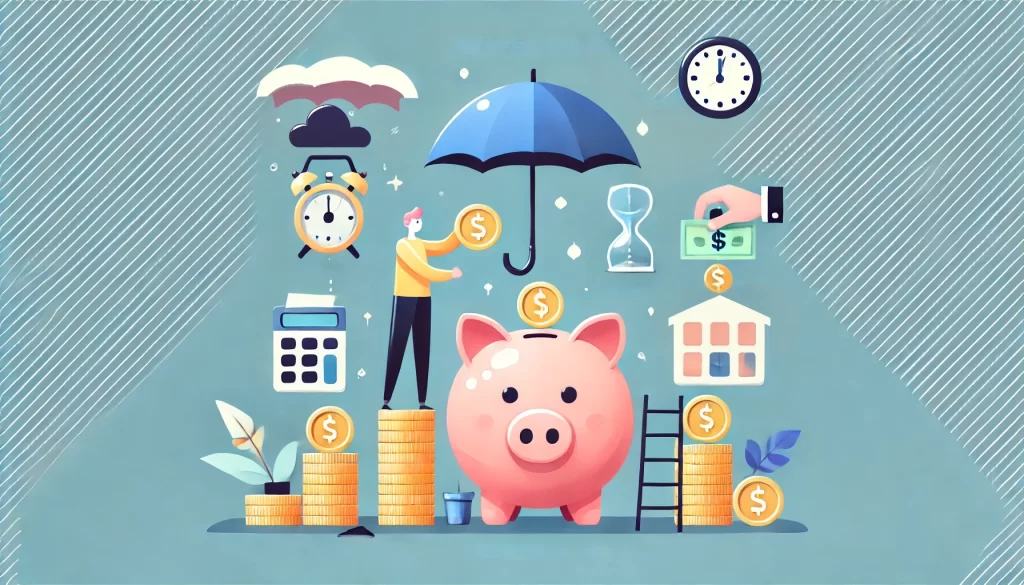I remember when my car broke down on the highway. Watching the tow truck take my car away was tough. It made me realize I had no emergency savings. That moment made me want to learn about building an emergency fund and getting financially secure.
If you’re like many Americans, you might struggle with your rainy day fund too. Did you know only 44% of us can handle a $1,000+ expense from savings? That’s a scary fact. But don’t worry, I’m here to share what I’ve learned about managing your finances and building that safety net.
In this guide, I’ll share seven proven ways to build your emergency savings fast. Whether you’re starting from scratch or want to grow your fund, these tips will help. They’ll give you a financial cushion that brings peace of mind. Let’s dive in and take control of our financial futures together!
Key Takeaways
- Only 44% of Americans can afford a $1,000+ expense from savings
- 53% have less than three months’ worth of emergency savings
- Experts recommend saving 3-6 months of expenses for emergencies
- 57% feel uncomfortable with their current emergency savings level
- Automated savings and rounding up purchases can help build funds
- Prioritize debt reduction alongside building emergency savings
- Consider career stage, income, and future goals when planning savings
Understanding the Importance of an Emergency Fund
Having a financial cushion is key for peace of mind. Let’s dive into why an emergency fund is vital. It prepares you for life’s unexpected turns.
What is an emergency fund?
An emergency fund is money saved for unplanned costs or lost income. It’s your safety net when life surprises you. This fund keeps you from using credit cards or loans, avoiding debt.
Why you need financial security
Being financially ready is crucial for unexpected expenses. Studies show those who can’t bounce back often have less savings. An emergency fund acts as a shield against future problems.
The psychology of having a safety net
Having a safety net lowers worry about money troubles. It’s not just about the money; it’s about feeling secure. Setting savings goals boosts motivation, helping you grow your emergency fund.
Remember, your emergency fund guards you against life’s surprises. By grasping its value and working on it, you ensure financial stability and peace of mind.
Setting Realistic Emergency Fund Goals
Financial planning can feel tough, but setting realistic goals for your emergency fund is key. We can break it down into steps to make it easier. This way, saving for emergencies won’t feel so hard.
Calculating Your Monthly Expenses
I start by tracking my spending and making a budget. This lets me see what I really need to spend on. I look at things like housing, utilities, food, and debt payments. It shows me how much I should save.
Determining Your Ideal Fund Size
Experts say to save 3-6 months of expenses. But if I’m the only one earning or my income changes, I aim for 9-12 months. A 2022 Bankrate survey found only 44% of people could handle a $1,000 emergency from savings. I don’t want to be in that spot.
| Income Situation | Recommended Emergency Fund |
|---|---|
| Stable dual income | 3-6 months of expenses |
| Single income or variable | 9-12 months of expenses |
Creating Achievable Milestones
I start small and set goals I can reach. Instead of aiming for three months’ worth right away, I start with one month. This keeps me going and helps me save more.
To keep moving forward, I set up automatic transfers to my emergency fund. Even small amounts, like $5 or $100, add up over time. It’s okay if reaching your goal takes time. Just start saving and keep going!
How to Build an Emergency Fund: Effective Saving Strategies
Building cash reserves is key for financial safety. Smart budgeting can quickly grow your emergency fund. Let’s look at some effective ways to save more.
First, set up automatic transfers from your paycheck to a savings account. Even small, regular savings add up over time. For example, saving $100 a month equals $1,200 in a year.
Reducing expenses can also help. I cut back on dining out, stopped subscriptions, and chose generic brands. These changes helped me save more for my emergency fund.
The Dave Ramsey baby steps suggest starting with a $1,000 emergency fund. But I aim for 3-6 months of living expenses. This bigger fund gives me more peace of mind when money troubles arise.
Here are more tips to increase your savings:
- Use high-yield savings accounts to earn more interest
- Save windfalls like tax refunds or work bonuses
- Sell unused items for quick cash
- Track your progress regularly to stay motivated
Building an emergency fund takes time and discipline. Be patient, stay consistent, and watch your financial safety net grow.
Smart Places to Keep Your Emergency Savings
When you save for emergencies, you want easy access and growth. I’ll show you smart spots for your money to grow while being easy to get to.
High-yield savings accounts
High-yield savings accounts are great for emergency funds. They give better interest rates than regular savings, often over 5% APY. An Ally online savings account, for example, has good rates and easy access to your cash.
Money market funds
Money market funds offer a bit more return. The Vanguard money market fund is a favorite, with short-term investments and quick access. But, some might need a minimum balance or have monthly fees.
Liquid assets vs. long-term investments
Liquidity is crucial for emergency savings. Long-term investments like stocks or bonds might grow more, but they’re not for quick needs. Fidelity cash reserves offer a good mix of easy access and some growth.
| Account Type | Liquidity | Potential Yield | Risk Level |
|---|---|---|---|
| High-yield savings | High | Up to 5% APY | Low |
| Money market funds | High | Variable, competitive | Low to moderate |
| Cash reserves | High | Modest | Low |
Remember, 67% of U.S. adults worry about covering immediate costs if they lost their primary income. By choosing the right place for your emergency fund, you can feel more secure. Whether it’s an Ally online savings account, a Vanguard money market fund, or Fidelity cash reserves, pick what fits your needs and keeps your money safe and easy to get to.
Conclusion
I’ve shared seven ways to quickly build an emergency fund. It’s clear that having one is very important. Only 39% of Americans can handle a $1,000 emergency, a Bankrate study found.
Creating a contingency fund is key for peace of mind. The average emergency costs $2,500 or more. So, it’s crucial to have money set aside.
Building your emergency fund doesn’t have to be hard. Start with saving $1,000 first. Then, aim to save 3 to 6 months of expenses.
Use automatic transfers, side hustles, and smart budgeting to reach your goals. Don’t overlook unexpected windfalls. The average tax refund in 2017 was $2,763, which could help start your savings.
Emergency preparedness is more than just having cash. It’s about feeling less stressed and more financially stable. By following these strategies and sticking to your plan, you’ll build a strong emergency fund. It might take time, but the benefits are worth it.






